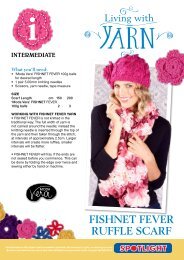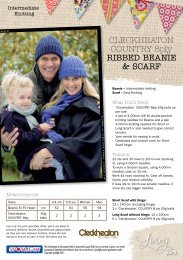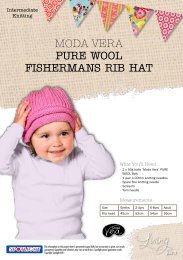e - Spotlight Promotions
e - Spotlight Promotions
e - Spotlight Promotions
Create successful ePaper yourself
Turn your PDF publications into a flip-book with our unique Google optimized e-Paper software.
• creative living<br />
fashion &<br />
sustainability...<br />
story and the life-cycle of clothes, and<br />
are willing to pay more for it all”.<br />
The Clean Clothes Campaign is an<br />
example of a group concerned with<br />
the rights and health of workers in<br />
the global garment and sportswear<br />
industries. It raises issues with<br />
governments, the media and<br />
consumers and encourages fashion<br />
producers to examine their practices.<br />
Such was the case when Versace,<br />
Gucci and Levi decided to stop using<br />
sandblasted denim. The sandblasting<br />
that gives jeans a used or worn look<br />
also contributes to a potentially lethal<br />
pulmonary disease in the workers who<br />
carry it out.<br />
On the opposite side of the coin are<br />
the individual designers or labels that<br />
are going directly into impoverished<br />
communities and working with them<br />
to create decorative components or<br />
complete garments and accessories<br />
that benefit everyone involved.<br />
The Polly & Me collection, ‘Peace<br />
of Cake’, was launched at the 2011<br />
Rosemount Australian Fashion Week.<br />
Australian designer Cath Braid began<br />
Polly & Me in 2003 as a social<br />
enterprise, working with around 1000<br />
female embroiderers in 19 centres<br />
across the remote valley of Chitral<br />
in Pakistan, to create the signature<br />
hand-embroidered cloth that adorns<br />
the label’s handbags, clutches and<br />
wallets. The aim is to encourage rural<br />
artisans to utilise their traditional craft<br />
in a contemporary way, promoting selfsufficiency<br />
and dignity.<br />
After the<br />
catastrophic 2010<br />
earthquake in Haiti<br />
American designer,<br />
Donna Karan,<br />
visited the island.<br />
According to Jan Breen Burns,<br />
other local fashion designers working<br />
hard to do the right thing are Alex<br />
Trimmer from Sosume, Rachel Bending<br />
from Bird Textiles and Lisa Gorman<br />
(Gorman).<br />
“These are all interesting designers<br />
who could tell you about the struggle<br />
to stick to your green principles, and<br />
the kind of compromises they will and<br />
won’t make, to compete in a market<br />
that still privileges fast, cheap, fashion<br />
with no ethics to speak of,” says Jan.<br />
Overseas the trend is developing<br />
in exciting ways too. Last year<br />
Deana Bianco, the UK-based editor<br />
of Runawaynow.com, a trend setting<br />
travel website, wrote an article about<br />
Ilaria Venturini Fendi (from the famous<br />
Fendi Italian fashion house) who was<br />
creating handbags made 100 per cent<br />
in Africa.<br />
“I wrote the article for the Eco<br />
Tourism section of our site,” explains<br />
Deana. “I write with my friends in<br />
mind; places they want to visit, things<br />
they want to do. People want to travel<br />
but they want to know they aren’t<br />
leaving a carbon footprint wherever<br />
they visit.”<br />
Deana says Stella McCartney<br />
was one of the first designers she<br />
remembers discussing ethical fashion.<br />
“I remember reading that she wouldn’t<br />
use leather or fur in her collection and<br />
I thought that was pretty punk,” says<br />
Deana. “The term really stuck with me<br />
64 spotlight.com.au www.facebook.com/gcqmag













